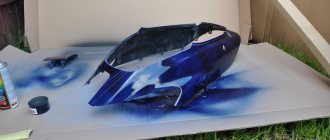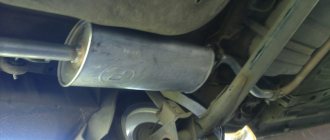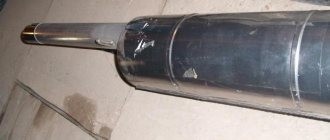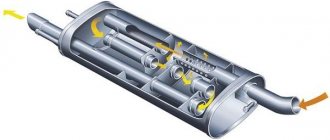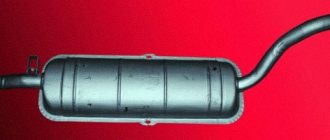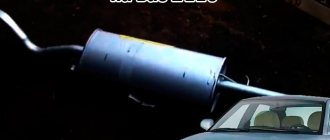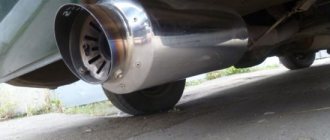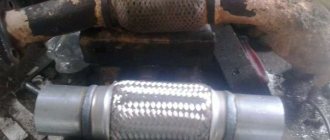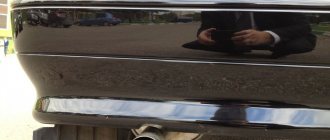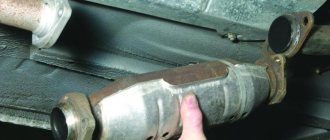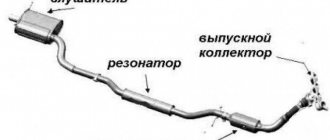Painting a car muffler: what paint to choose and how to use it correctly
A muffler is part of a car's exhaust system.
It performs a vital role - it silently removes exhaust gases from the combustion chamber, which allows the engine to operate without interruption. The muffler gets very hot during machine operation, is regularly exposed to moisture, and without certain protection it can rust and wear out quickly. In order not to spend money on repairing or replacing a part, it is worth painting it. For this purpose, special paint for the muffler is suitable, which will reduce the rate of aging of the metal and will serve as a corrosion prevention.
Painting a car muffler
Painting a car muffler
An automobile system contains a certain number of different mechanisms.
The main function is the presence of an exhaust system, that is, the removal of already exhaust gases from the combustion chamber, which is present in the engine. As a rule, the operating temperature of all parts of the exhaust system varies not by tens, but by hundreds of degrees, so painting the muffler should be done as competently as possible. During the production process, such elements are treated with the most common high-quality anti-corrosion compounds. They are designed to effectively protect the metal from damage by destructive corrosion and from damage during transportation, since the coating burns very quickly when the engine is running.
There is another risk factor, which is the contact of elements of the exhaust system with dirt and moisture. This usually happens while the vehicle is moving, since all such parts are mounted under the bottom of the car. Hot metal reacts to these factors much more than metal that is at rest.
Choosing heat-resistant paint for the muffler
In the production of exhaust system elements, a special anti-corrosion coating is used, which is applied to all heated areas. In new cars, the muffler protection is still reliable, but over time, especially with active use of the equipment, it weakens. After the factory protective film burns, it will need to be restored.
Painting a muffler is an effective way to extend its “life,” which is shortened by thermal shock, condensation, and temperature changes. Choosing paint is a difficult matter, because the material must meet a number of conditions. During operation, the muffler heats up to +500…+700 degrees, so the paint must be heat-resistant and can withstand significant increases in temperature. Conventional paintwork will quickly become unusable in such conditions, and the work will have to be done again.
High temperature paint EUROCOLOR
Some car owners paint the muffler with fireplace paints. In fact, this approach is irrational, because such materials are sold in large packages. Automotive stores offer a sufficient selection of paints and varnishes in cans or cans, and such paints have the ability to withstand temperature changes over a wide range.
Silicone paint is perfect for working with the exhaust system. It is characterized by wear resistance, strength, and heat resistance. Organosilicon-based coatings have also proven themselves to be excellent, as they additionally have the ability to protect metal from corrosion. They withstand temperature changes ranging from -60...+600 degrees, increase the service life of parts, and contain additives that ensure easy application and quick drying.
Heat-resistant silicone enamel.
If you use really high-quality compounds to paint the muffler, you can be sure that the exhaust system is protected from the following:
Good heat-resistant paint can be applied in different ways (roller, brush, spray), has high strength and can be applied to metal even at sub-zero ambient temperatures.
Muffler painting instructions
Before painting a car muffler, to prevent the assembly from rusting, you must thoroughly clean the surface of the old coating. This is a mandatory stage on which the strength and reliability of the subsequent coating, effective protection against corrosion and wear depend. When painting the most important part of the exhaust system, special attention should be paid to the quality of its cleaning from rust, dirt and old coating. The heat-resistant composition ideally fits only on a well-prepared surface.
Preparation
For cleaning you can use: – a stiff brush with wire bristles; – chemical removers; – figured scraper; - heat gun. When using a brush with stiff wire bristles, rust can often be found under a layer of paint and dirt, the area of which must be additionally treated with epoxy putty. Chemical strippers can be used before applying heat-resistant (heat-resistant) spray paint to the muffler. These active substances are excellent for cleaning the surface of a part from old organic or water-soluble paints. They are applied in a thick, dense layer to the part. To do this, use a brush with natural bristles. Then the paint is removed using a spatula or wooden spatula. After this, the surface should be wiped dry with a clean rag or napkins. A shaped scraper is used when preparing an exhaust system element for painting. It's convenient to use. To achieve a perfectly smooth surface, it is necessary to sand using medium-grain sandpaper or a special machine. Heat-resistant spray paint for the muffler adheres well to a surface that has been cleaned of the old enamel layer using a heat gun. This tool must be used with extreme caution, observing fire safety regulations. To do this, it is recommended to place a piece of damp cloth under the part during heat treatment.
Important! A heat gun cannot be used if it is made with a large amount of lead. This chemical element evaporates when heated, so it can be harmful to health.
Painting
If you have already decided on how to paint the car muffler so that it does not rust, you can start painting. This stage has its own difficulties. During the process of painting the muffler, smudges often form. They can worsen the performance characteristics of the unit and do not look aesthetically pleasing at all. To prevent the formation of sagging, you must adhere to a simple technology: – the enamel must be applied in thin layers, each time after complete drying; – the spray gun should be held at the same distance from the surface; – do not move the sprayer at an angle or in an arc; – the sprayed substance should capture not only the edges of the part, but also extend beyond its boundaries; – each strip must be applied evenly to the previous painted areas.
Instructions for painting the muffler
First, you should remove the part from the car and evaluate its general technical condition. It is important to find all areas of rust and clean them, as well as carefully remove the old coating that has begun to crumble. The service life of the new coating, its strength and the effectiveness of corrosion protection will depend on the quality of this work.
Preparing for work
Preparatory activities can be carried out using different tools and methods. In any case, after preparation is completed, the metal should be clean, without traces of paint, rust, dirt, or oil. If corrosion particles remain on the muffler, the rusting process will continue under the paint layer. After stripping the metal, it is puttied with special epoxy materials.
Options for cleaning surfaces from old paint
To clean the muffler you can use the following devices:
- Hard brush. Select a durable brush with wire bristles, which is used to treat the metal surface. All rusty areas are cleaned especially carefully, after which putty is applied.
- Figured scraper. This tool is very easy to use. They apply pressure to the muffler, making horizontal and vertical movements. Finish the job with sandpaper.
- Chemical remover. The product is excellent for removing water-soluble or organic paints. The part is treated with a remover using a brush, and after some time the rolling coating is removed with a spatula or wooden spatula. If necessary, the operation is repeated. At the end of the work, wipe the metal dry with napkins or rags.
- Heat gun. This device is great for cleaning the muffler, but it must be used with caution. First, place a wet rag under the part, then turn on the gun and point it at the surface of the muffler. After the old paint begins to swell, the gun is turned off and the coating is removed with a scraper or napkin. If the muffler contains lead, this method is not used, since the fumes will be harmful to health.
Paint remover
Muffler painting
Painting is a fairly simple stage of work when compared with preparatory measures. The paint is applied in thin layers (2-4 layers in total), after each time wait until the coating is completely dry. You should not rush, otherwise drips or sagging may form on the metal, or some areas will remain unpainted. You can work with a brush or roller, but the easiest way to perform all the manipulations is with a small spray gun. Aerosol paint is no less easy to apply; you just need to spray it from a can from 15-20 cm.
If the paint is applied using a spray gun, its nozzle is kept at the same distance, and care is taken that it is the same over the entire area being treated. When the sprayer is tilted, the paintwork will lie unevenly. Each subsequent strip of paint is applied so that it slightly overlaps the previous one.
Heat treatment
Drying under heat is an important stage in the muffler painting process. For drying, use a hair dryer or oven, where the part can be calcined at a temperature of +160...+200 degrees. If you ignore calcination of the paint layer, it will remain soft and can be damaged while driving.
The time for heat treatment is about 15-20 minutes. During this period, you need to put the muffler in the oven or blow it thoroughly with a hairdryer, moving the device in both directions.
In order for a car to behave confidently on the road, all its parts and systems must be maintained in good condition. An excellent condition of the muffler means silent and comfortable movement, prevention of engine breakdowns and no problems with the police. Painting the part will extend its service life and save you from a lot of troubles along the way.
Source of the article: https://kraska.guru/kraski/avtomobilnaya/dlya-vyxlopnoj-truby.html
How to paint a car muffler
Content
What you need to paint a car
What paint is better to paint the muffler?
Preparing for the painting process
Coloring instructions
Recommendations from the author
To keep a part of one of the most important car systems in proper condition, you will need paint for the muffler. It is best to use silver paint, which is what the muffler is coated with at the factory.
The exhaust system is one of the main mechanisms for the correct and smooth operation of the entire vehicle. Its task is to remove exhaust gases that are formed in the combustion chamber. All parts of the system heat up during engine operation to very high temperatures, amounting to hundreds of degrees. The exhaust pipe, when heated, quickly becomes unusable, and the paint on it, under the influence of high temperatures, simply burns. This reduces the protection of metal parts, and they are subject to corrosion and other negative influences.
The pipe is located in the lower part of the car, therefore it is subject to the mechanical influence of sand and small stones that fall on it during movement. The action of chemical reagents also negatively affects the condition of the metal. Moisture is the main enemy of metal. Insufficient protection will lead to rust and damage the exhaust pipe very quickly.
During the manufacturing process of vehicles, parts are necessarily treated with high-quality anti-corrosion agents, however, high temperatures destroy the protective layer and to keep the car in the required condition, the protective layer must be regularly updated. Car owners who monitor the condition of their iron friend are always faced with the question of how to paint the car muffler.
To extend the life of the exhaust pipe, drivers resort to the following tricks:
- drilling holes for condensate to escape;
- painting the exhaust pipe with special paint that prevents corrosion.
One hole in the muffler body will be enough. The resulting condensate will drain through it, preventing the accumulation of water and rusting of metal parts.
Painting will serve as protection against rust and prevent rapid aging of the metal due to high temperatures, which can reach four hundred degrees.
What you need to paint a car
Painting a car is a very responsible process. It is best to use the services of special auto painting workshops. They have all the necessary equipment and materials. The work will be completed quickly, and you will be confident in the quality of the painting.
Pneumatic spray gun
If you still decide to carry out painting work, then before you start, you need to prepare the following equipment:
- spray gun;
- compressor;
- polishing machine or drill with attachments;
- mobile light source;
- construction hair dryer;
- grinding machine (grinder);
- personal protective equipment.
All of the above tools may not always be needed. A spray gun can easily replace canned paint if you don’t need to paint the entire car body. It is not advisable to purchase a hair dryer for painting individual parts. But gloves, a protective suit and a painting mask should not be neglected.
In addition to the necessary tools, the following materials are required to paint a car:
- abrasives;
- putty;
- priming;
- solvent and degreaser;
- dye;
- varnish
All painting materials should be purchased of high quality, preferably from trusted manufacturers. Following the instructions will help you avoid trouble and the work will not have to be redone. To understand the question of how to paint the muffler, you should know the features of this car part. Due to exposure to high temperatures, ordinary paint cannot be used to paint the exhaust pipe. It will quickly burn and the work will have to be done again. There is a wide selection of paint and varnish products from different brands on store shelves. Thermal paint for the muffler is the best option for painting this part.
What paint is better to paint the muffler?
Parts such as the muffler cannot be painted with the usual paint that we use to paint a car body. To get the best results and lasting effect, you should use heat-resistant paint. Some drivers use fireplace paint for painting work. But this is absolutely not rational. There are currently many special heat-resistant dyes on the shelves of auto stores.
Silicone-based heat-resistant paint for car mufflers has proven itself to be excellent. It can withstand high temperatures and has excellent durability. Apply in several layers, allowing to dry. There is no need to prime the surface before painting, which greatly simplifies the process.
There is a certain feature that distinguishes heat-resistant paint from regular paint. In order for it to dry, the surface after painting must be heated to a temperature of 160–200 degrees. If this is not done, the layer can be easily damaged. Because the paint will remain soft. It hardens only when heated. After painting, the muffler is heated to the desired temperature using a hairdryer. If you don't have one, you can use the oven. The time required to dry the layers is 15–20 minutes.
But the best option is to paint the calipers with silver enamel. Surely it has been tested and will not require large expenses.
Heat-resistant enamel KUDO
Preparing for the painting process
Any process, especially when it comes to painting, requires careful preparation. This is the only way to get the expected result, and the work will delight you for a long time. Cleaning the surface is the most important step, and if it is not done well enough, you may not waste effort on other processes. The result will be disastrous in any case.
The surface of the muffler should be cleaned of old coating and the metal should be free of rust and other contaminants. If traces of rust are not completely removed, the part will continue to rust, destroying both the part itself and the layer of paint on it.
Cleaning methods:
- Clean with a brush with metal bristles or a drill with cleaning wheels. If the rust has eaten a hole through the surface, cover it with a layer of putty.
- To remove the previous layer of paint, you can use chemical removers designed for this purpose. They can remove organic compounds and waterborne paints.
- Using a heat gun can cause the paint to bubble up and remove it easily.
If there is lead in the parts being processed, the gun cannot be used. The heating process provokes the evaporation of harmful substances, which is harmful to health. After thorough cleaning, the surface should be puttied. The final process is sanding.
Preparing to paint the muffler
Coloring instructions
The work of painting a muffler differs little from regular painting of a car body. The paint should be applied slowly, in thin layers, maintaining intervals between them. Be sure to ensure that no leaks form. It is best to carry out the work using a spray gun. It's easy and gives excellent results. It should be held exclusively straight. If you paint while pointing the spray gun at an angle, streaks and sagging will form on the surface of the muffler.
Drying is an important and integral step in the process. It takes a lot of time. Instead of an oven or hairdryer, you can dry the outer side of the part painted with heat-resistant paint by baking. This process can be entrusted to the engine of the car while it is moving.
Stages:
- Choose paint. Silicone-based enamel is perfect. It is distinguished by ease of application and quick drying process.
- Preparing the muffler for painting. Remove corrosion and old paint layers. The surface is cleaned using any convenient method.
- Direct painting. There should be several layers. Be sure to dry between applications.
- Dry the surface using a hair dryer or heat it at a temperature of 160–200 degrees.
Muffler painting
Recommendations from the author
A car muffler is a part that needs to be painted with particular seriousness. This is due to the fact that during operation it heats up to significant temperatures, and this makes it impossible to use ordinary paint for painting. The painting process is needed not only to give the muffler an aesthetically attractive appearance, but also to extend its service life by protecting it with a layer of paint from the negative effects of the external environment and preventing the rusting process.
By following all stages of preparation, application and drying, you are guaranteed to get an excellent result and achieve your goals. Do not forget to follow safety rules when working, and also monitor the expiration date of the materials used.
The most interesting and popular articles on our channel in Yandex.Zen
Composition of fire-resistant dyes
Heat-resistant enamel differs in its composition from conventional paints and varnishes by its components. The composition, in addition to the standard set of components, includes titanium dioxide (up to 50% of the substance). The melting point of the dioxide is +1855 degrees C. It combines all components into one mass and prevents the paint from igniting.
Heat-resistant paint also contains chromium oxide. It ensures color fastness on the product. The liquid base can be synthetic or organic without flammable substances. This composition is ideal for operation at temperatures above 1000 degrees C.
Attention! To operate items at temperatures not exceeding 200 degrees C, you can use epoxy enamel.
Scope of application
High temperature paint is used for painting:
- Radiators (heating radiators);
- Engine parts;
- Stoves, fireplace, barbecue.
Important! The manufacturer indicates the area of application on the packaging. When choosing, you should carefully read what surfaces this paint is suitable for.
To paint a product, object, part that gets very hot, use:
- Heat-resistant enamel. It is used to cover parts that heat up to 700 degrees C. Heat-resistant paint is suitable for coating stoves and fireplaces.
- Fireproof for iron. It can withstand open fire.
- High temperature enamel for painting a heating radiator. The paintwork can withstand temperatures up to 250 degrees. You can cover a brick oven or treat the seams.
- Heat-resistant enamel for coating objects that heat up to 300-350 degrees C.
Top 7 fireproof paints for metal up to 1000 degrees
To protect a heating radiator, metal stove or other objects from corrosion and aggressive external influences, they are coated with heat-resistant paint and varnish enamels. The paint and varnish coating can withstand up to 1000 degrees C. Enamel not only protects, but also gives an aesthetic appearance.
Making a choice in favor of one paint or another is difficult. A fresh coating will give the products a new appearance. We have compiled for you a rating of the most popular paint coatings. All submitted candidates have been verified by operational practice and experience.
Tikkurila termal silikonimaali
Country of origin: Finland and Russia. Used for painting metal products. Based on silicone resin. Suitable for indoor and outdoor use. Resistant to high temperatures up to 400 degrees. This property provides protection for chimney pipes and dampers. Used for painting car muffler. Black color. After drying, a semi-matte shine is formed. Protects the metal structure.
Apply with a brush or spray. Complete drying time at a temperature of +230 C is exactly 1 hour. You can use cleaning products to wash the surface after one month. One liter of enamel is designed for 16-20 square meters. If the paint is applied in one layer. The price corresponds to the quality. The only minus is heat treatment after application to ensure complete drying.
Celsite-600
Black paint. Withstands temperatures up to +600 degrees. High degree of protection when using metal under the influence of high temperatures and moisture. Resistant to the influence of petroleum products, oil, gasoline. Used for painting: electric motors, transformers, household heating appliances, bridges, tanks, metal structures, railway tanks, calipers. Can be applied to reinforced concrete, asbestos-cement, brick, plastered surfaces. The enamel is applied in three layers. The color is black, the surface acquires a matte tint.
Certa KO-85
Certa is used for items that operate at temperatures from -50 to 900 degrees C. Heat-resistant enamel. Tolerates temperature changes well, including high temperatures. Protects against aggressive environments and high levels of humidity. Prevents corrosion and moisture ingress. Apply at minus 30 degrees Celsius. Transparent paint material. Used instead of varnish to coat brick, concrete, and ceramics. Apply in three layers to achieve a matte finish. In one layer, the brick acquires a wet effect.
Elcon
To obtain the desired color it is mixed with colorant. At the same time, the pigment contained reduces the level of protection and durability of the painted coating.
The color palette is very rich. The gloss can be matte or glossy. A product painted in classic black can be heated up to 1000. And all other colors are not higher than 700 degrees. You can create beautiful patterns on the walls using a stencil without involving specialists. In addition to metal surfaces, it protects concrete, brick, and asbestos products from the influence of aggressive environments.
The composition does not contain toxic components. When used, harmful substances are not released into the air. Can be used inside a living room, stove or fireplace, chimney. There is no need to apply a primer before application. Complete drying time 2 hours. It is considered slightly flammable and difficult to ignite. The room temperature is not lower than +3C. Service life is at least 20 years. Universal, can be used on products of different surfaces.
Matte paint for interior and exterior work. Used for painting car exhaust systems, chimneys, and chimneys. Black color. Before opening the can, the manufacturer recommends stirring the contents well. Apply by brush or spray. Drying time from 1 to 3 hours. If you want to apply several layers to the product, then the time interval for each layer is 1 hour. Thermal curing for 2 hours at 200 degrees.
Heat-resistant silver oxide Novbytkhim
Heat-resistant universal. Used for glass, brick, concrete, plaster surfaces. The resulting layer protects against oil, gasoline, water, and steam, salt fog in the range from – 50 to +600 degrees Celsius. Withstands sudden temperature changes, but within the range indicated on the package. The enamel is waterproof and dries quickly. Apply no more than three layers. Stir not only before application, but also during application. Pre-prepare the surface. Clean from dust and dirt. Contains organic substances.
Source of the article: https://www.bazaznaniyst.ru/termostojkaya-kraska/
Painting a car muffler: what paint to choose and how to use it correctly
Painting a car muffler with fire-resistant powder paints, as a rule, takes place in an industrial environment. The composition, in comparison with silicone heat-resistant analogues, makes it possible to withstand higher temperatures. The main disadvantage is the difficulty of application.
Author of the article: Yaroslav Alchevsky 09.09.2020 0 0
The exhaust system of a car, which removes exhaust gases, can heat up to a temperature of several hundred degrees. Therefore, the paint on the pipe burns over time, which reduces the protection. Because of this, the part suffers from corrosion. Therefore, car enthusiasts often decide to paint the car muffler to prevent it from rusting.
The need to paint the muffler
Painting a car muffler is required not only to effectively protect this element from corrosion, but also to completely prevent the fairly rapid aging of the metal, which occurs under the strict influence of thermal shock. The outer part of the muffler is usually cooled under a certain influence of the ambient temperature. At the same time, in its internal part there is a negative impact of hot exhaust gases. Also, a certain amount of condensation forms in the muffler, which after some time causes corrosion.
Due to a fairly large number of unfavorable factors that affect a car, a muffler without high-quality protection will not last for a long time.
Protect your car muffler from corrosion
To increase the service life of the exhaust pipe, car enthusiasts use two main methods:
The first method allows condensation to escape, thereby preventing the accumulation of liquid and the formation of rust. Despite its effectiveness, not all motorists are ready for such radical interventions.
So, painting a car muffler with special paint to prevent it from rusting is often the only way to combat corrosion. This protects against rust and prevents accelerated aging of the metal from high temperatures. The best option is to paint the calipers with silver enamel: this is a reliable method, moreover, it is pleasant and affordable.
Is it allowed to paint the muffler on a car?
Whether to paint the exhaust pipe is up to you. The factory paint, which is mainly responsible for its presentable appearance, begins to lose its integrity soon after purchasing the car. In addition, scratches are possible already during installation, and welding work reduces the protective characteristics of the top layer.
Rusty car muffler
Although it is not covered with anything on the inside, when properly applied to protect the car muffler from corrosion on the outside, the paint still protects for some time, significantly extending the life of the part.
Can mufflers be painted?
Can mufflers be painted?
The car muffler, just like the resonator, as well as other components of the exhaust system, are exposed to aggressive environments.
All this seriously affects their service life, so a completely reasonable question arises: how to protect the muffler and is it possible to paint the muffler? There are options for mufflers that already have a protective coating in the form of a layer of aluminum or a layer of zinc, not to mention expensive spare parts made of stainless steel. There is no particular point in applying paint to them, but it is quite possible to protect parts made of ordinary black steel. Among the aggressive influences, the most powerful are:
If you paint a car muffler against these factors, you can temporarily protect the exhaust system.
How to protect the muffler from corrosion?
To get a more or less effective option for exhaust protection, you should correctly determine what to paint the car muffler with.
To do this, you should take high-quality heat-resistant paint. The temperature of the muffler may be more than 100 C, and the temperature of the collector may be more than 600-700 C. If you paint not only the muffler, then this must be taken into account! By the way, this is the paint that mufflers are painted at some manufacturing plants. The choice of what paint to use is yours, since there are many options on the market and many manufacturers for how to paint a car muffler.
And so, before painting the muffler you should:
If you don’t have a spray bottle, you can paint the muffler with a regular brush, if you do it carefully.
Do I need to paint the muffler?
At manufacturing plants, mufflers are painted to give them a marketable appearance, and so that they look presentable until the time of sale.
As soon as the muffler is installed, its surfaces are exposed to aggressive conditions and the paint layer disappears quite quickly. It should also be taken into account that during installation the paint layer suffers from minor scratches or welding, which effectively negates such protection. The interior of the muffler is not coated with paint and is exposed to corrosion and temperature directly, so protecting only the outer surfaces with paint does not seem to be very effective.
Despite all this, a layer of paint, properly applied to the outer surface of the muffler, still protects it for some time, and this protection may well slightly increase the operating time of the part.
Whether or not to paint the muffler is up to you. If you want your muffler or any other component of your car exhaust system to serve you for a long time, then choose high-quality parts from manufacturers you trust.
Source
Classification
Restoring car interior plastic
There are different ways to classify paints. For example, they can be divided by packaging. You can buy fireproof paint for metal in aerosol cans, cans, buckets and barrels. From 1 kg of paint are packaged in cans. In buckets there are 10, 15 and 20 kg packaging, and in barrels - 40 kg or more. Aerosol cans for paint are usually produced in 400-500 ml capacity.
The shelf life of thermal paints differs for different brands, but it is never less than 7 months.
Paints are also distinguished by the method of applying them to the surface. There are 3 known methods: brush, roller and spray. How the paint is applied to the surface determines its consumption. So, if the enamel is applied with a brush and a spray bottle, then in the first case the consumption will be 10-40% more. In this case, the durability of the coating will be approximately the same. Also, the consumption of the substance will be higher when using an aerosol.
Whenever fire-resistant paint for metal is applied to a surface, it must demonstrate excellent adhesion, that is, sticking to the surface. Accordingly, protection against corrosion will be reliable.
Selection of paint for a car muffler
Choose paint for the muffler based on the following basic parameters:
- Heat resistance (the higher the better: the exhaust pipe can heat up to 600 degrees, so its temperature range should be from -35 to 600 degrees Celsius).
- Anti-corrosion.
- Waterproof.
- Painting characteristics: structural uniformity, color saturation, drying speed.
It is best to buy silicone enamel or heat-resistant varnish.
Heat resistant
Silicone heat-resistant paints are popular among car enthusiasts because they are easy to use (applied in several layers and do not require a primer).
Painting a car muffler with a heat-resistant compound not only protects against rust, mechanical damage and chemicals, but also extends the life of the exhaust pipe, making it resistant to high temperatures.
Heat resistant paint for muffler
There is an important point that distinguishes heat-resistant paint for the muffler: in order for it to harden, the composition must be heated to 160–200 degrees. This can be done using a hair dryer or high temperature oven. The drying period for each layer is 15–20 minutes.
Fireproof
Painting a car muffler with fire-resistant powder paints, as a rule, takes place in an industrial environment. The composition, in comparison with silicone heat-resistant analogues, makes it possible to withstand higher temperatures. The main disadvantage is the difficulty of application.
Serebryanka
The best paint for a car muffler is silver. At service stations, it is most often made silver or black: these shades can withstand temperatures of up to 600 degrees in the short term, and up to 400 degrees in the long term. Other colors are less heat resistant.
Content
What you need to paint a car
What paint is better to paint the muffler?
Preparing for the painting process
Coloring instructions
Recommendations from the author
To keep a part of one of the most important car systems in proper condition, you will need paint for the muffler.
It is best to use silver paint, which is what the muffler is coated with at the factory. The exhaust system is one of the main mechanisms for the correct and smooth operation of the entire vehicle. Its task is to remove exhaust gases that are formed in the combustion chamber. All parts of the system heat up during engine operation to very high temperatures, amounting to hundreds of degrees. The exhaust pipe, when heated, quickly becomes unusable, and the paint on it, under the influence of high temperatures, simply burns. This reduces the protection of metal parts, and they are subject to corrosion and other negative influences.
The pipe is located in the lower part of the car, therefore it is subject to the mechanical influence of sand and small stones that fall on it during movement. The action of chemical reagents also negatively affects the condition of the metal. Moisture is the main enemy of metal. Insufficient protection will lead to rust and damage the exhaust pipe very quickly.
During the manufacturing process of vehicles, parts are necessarily treated with high-quality anti-corrosion agents, however, high temperatures destroy the protective layer and to keep the car in the required condition, the protective layer must be regularly updated. Car owners who monitor the condition of their iron friend are always faced with the question of how to paint the car muffler.
To extend the life of the exhaust pipe, drivers resort to the following tricks:
- drilling holes for condensate to escape;
- painting the exhaust pipe with special paint that prevents corrosion.
One hole in the muffler body will be enough. The resulting condensate will drain through it, preventing the accumulation of water and rusting of metal parts.
Painting will serve as protection against rust and prevent rapid aging of the metal due to high temperatures, which can reach four hundred degrees.
What you need to paint a car
Painting a car is a very responsible process. It is best to use the services of special auto painting workshops. They have all the necessary equipment and materials. The work will be completed quickly, and you will be confident in the quality of the painting.
Pneumatic spray gun
If you still decide to carry out painting work, then before you start, you need to prepare the following equipment:
- spray gun;
- compressor;
- polishing machine or drill with attachments;
- mobile light source;
- construction hair dryer;
- grinding machine (grinder);
- personal protective equipment.
All of the above tools may not always be needed. A spray gun can easily replace canned paint if you don’t need to paint the entire car body. It is not advisable to purchase a hair dryer for painting individual parts. But gloves, a protective suit and a painting mask should not be neglected.
In addition to the necessary tools, the following materials are required to paint a car:
- abrasives;
- putty;
- priming;
- solvent and degreaser;
- dye;
- varnish
All painting materials should be purchased of high quality, preferably from trusted manufacturers. Following the instructions will help you avoid trouble and the work will not have to be redone. To understand the question of how to paint the muffler, you should know the features of this car part. Due to exposure to high temperatures, ordinary paint cannot be used to paint the exhaust pipe. It will quickly burn and the work will have to be done again. There is a wide selection of paint and varnish products from different brands on store shelves. Thermal paint for the muffler is the best option for painting this part.
What paint is better to paint the muffler?
Parts such as the muffler cannot be painted with the usual paint that we use to paint a car body. To get the best results and lasting effect, you should use heat-resistant paint. Some drivers use fireplace paint for painting work. But this is absolutely not rational. There are currently many special heat-resistant dyes on the shelves of auto stores.
Silicone-based heat-resistant paint for car mufflers has proven itself to be excellent. It can withstand high temperatures and has excellent durability. Apply in several layers, allowing to dry. There is no need to prime the surface before painting, which greatly simplifies the process.
There is a certain feature that distinguishes heat-resistant paint from regular paint. In order for it to dry, the surface after painting must be heated to a temperature of 160–200 degrees. If this is not done, the layer can be easily damaged. Because the paint will remain soft. It hardens only when heated. After painting, the muffler is heated to the desired temperature using a hairdryer. If you don't have one, you can use the oven. The time required to dry the layers is 15–20 minutes.
But the best option is to paint the calipers with silver enamel. Surely it has been tested and will not require large expenses.
Heat-resistant enamel KUDO
Preparing for the painting process
Any process, especially when it comes to painting, requires careful preparation. This is the only way to get the expected result, and the work will delight you for a long time. Cleaning the surface is the most important step, and if it is not done well enough, you may not waste effort on other processes. The result will be disastrous in any case.
The surface of the muffler should be cleaned of old coating and the metal should be free of rust and other contaminants. If traces of rust are not completely removed, the part will continue to rust, destroying both the part itself and the layer of paint on it.
Cleaning methods:
- Clean with a brush with metal bristles or a drill with cleaning wheels. If the rust has eaten a hole through the surface, cover it with a layer of putty.
- To remove the previous layer of paint, you can use chemical removers designed for this purpose. They can remove organic compounds and waterborne paints.
- Using a heat gun can cause the paint to bubble up and remove it easily.
If there is lead in the parts being processed, the gun cannot be used. The heating process provokes the evaporation of harmful substances, which is harmful to health. After thorough cleaning, the surface should be puttied. The final process is sanding.
Preparing to paint the muffler
Coloring instructions
The work of painting a muffler differs little from regular painting of a car body. The paint should be applied slowly, in thin layers, maintaining intervals between them. Be sure to ensure that no leaks form. It is best to carry out the work using a spray gun. It's easy and gives excellent results. It should be held exclusively straight. If you paint while pointing the spray gun at an angle, streaks and sagging will form on the surface of the muffler.
Drying is an important and integral step in the process. It takes a lot of time. Instead of an oven or hairdryer, you can dry the outer side of the part painted with heat-resistant paint by baking. This process can be entrusted to the engine of the car while it is moving.
Stages:
- Choose paint. Silicone-based enamel is perfect. It is distinguished by ease of application and quick drying process.
- Preparing the muffler for painting. Remove corrosion and old paint layers. The surface is cleaned using any convenient method.
- Direct painting. There should be several layers. Be sure to dry between applications.
- Dry the surface using a hair dryer or heat it at a temperature of 160–200 degrees.
Muffler painting
Recommendations from the author
A car muffler is a part that needs to be painted with particular seriousness. This is due to the fact that during operation it heats up to significant temperatures, and this makes it impossible to use ordinary paint for painting. The painting process is needed not only to give the muffler an aesthetically attractive appearance, but also to extend its service life by protecting it with a layer of paint from the negative effects of the external environment and preventing the rusting process.
By following all stages of preparation, application and drying, you are guaranteed to get an excellent result and achieve your goals. Do not forget to follow safety rules when working, and also monitor the expiration date of the materials used.
- Home / Exhaust system /
- Can mufflers be painted?
Can mufflers be painted?
The car muffler, just like the resonator, as well as other components of the exhaust system, are exposed to aggressive environments.
All this seriously affects their service life, so a completely reasonable question arises: how to protect the muffler and is it possible to paint the muffler? There are options for mufflers that already have a protective coating in the form of a layer of aluminum or a layer of zinc, not to mention expensive spare parts made of stainless steel. There is no particular point in applying paint to them, but it is quite possible to protect parts made of ordinary black steel. Among the aggressive influences, the most powerful are:
- temperature changes, especially in winter;
- changes in humidity and the presence of moisture in the exhaust;
- salts and reagents that melt ice and snow on roads in winter; they destroy car exhaust parts;
- minor mechanical damage (from small stones, debris, etc.);
If you paint a car muffler against these factors, you can temporarily protect the exhaust system.
How to protect the muffler from corrosion?
To get a more or less effective option for exhaust protection, you should correctly determine what to paint the car muffler with.
To do this, you should take high-quality heat-resistant paint. The temperature of the muffler may be more than 100 C, and the temperature of the collector may be more than 600-700 C. If you paint not only the muffler, then this must be taken into account! By the way, this is the paint that mufflers are painted at some manufacturing plants. The choice of what paint to use is yours, since there are many options on the market and many manufacturers for how to paint a car muffler.
And so, before painting the muffler you should:
- thoroughly clean the surface of the muffler, you can “sandblast”;
- treat the muffler with a rust converter;
- wash off the rust converter with water or carefully remove it with a rag;
- degrease with solvent (an important point);
- prime;
- paint the muffler, while applying heat-resistant paint, preferably from a spray bottle, to minimize smudges.
If you don’t have a spray bottle, you can paint the muffler with a regular brush, if you do it carefully.
Do I need to paint the muffler?
At manufacturing plants, mufflers are painted to give them a marketable appearance, and so that they look presentable until the time of sale.
As soon as the muffler is installed, its surfaces are exposed to aggressive conditions and the paint layer disappears quite quickly. It should also be taken into account that during installation the paint layer suffers from minor scratches or welding, which effectively negates such protection. The interior of the muffler is not coated with paint and is exposed to corrosion and temperature directly, so protecting only the outer surfaces with paint does not seem to be very effective.
Despite all this, a layer of paint, properly applied to the outer surface of the muffler, still protects it for some time, and this protection may well slightly increase the operating time of the part.
Whether or not to paint the muffler is up to you. If you want your muffler or any other component of your car exhaust system to serve you for a long time, then choose high-quality parts from manufacturers you trust.
Painting the muffler extends the service life of the part
Confidence on the road depends on many factors. One of them is the condition of the exhaust manifold. A serviceable part ensures silent, comfortable movement on the road. The “growling” sound is perceived ambiguously by other road users and attracts the attention of traffic police officers. Do you want to drive safely and comfortably? Choose the “right” paint for the exhaust manifold.
Properties of heat-resistant paint: advantages and scope, types of compositions and coating technology
How to paint a metal stove in a bathhouse?
Do-it-yourself technology for painting chimneys: choosing paint and step-by-step instructions for painting from different materials
Choosing paint in a spray can for painting a car: main problems and methods for choosing the composition
Painting a refrigerator: choice of paintwork materials, technology features, tips
Painting options
The main task of paint for the exhaust system is to withstand high temperatures. Therefore, the only suitable option for painting the muffler is heat-resistant paints. In practice, two main options for exhaust pipe paints are most often used.
- Silicone heat-resistant paints. They are in demand among amateurs, as they do not require specific conditions or special skills from the car owner for application. Sold in both standard cans and aerosol cans. Resists high temperatures well. However, it has been noticed that the exhaust manifold painted with this paint will peel off quite quickly. And on colder elements remote from the engine, such as a resonator, catalyst or muffler itself, silicone paint holds up well.
- Powder heat-resistant paints. Typically used in industrial settings. Able to withstand higher temperatures than silicone options. However, they are more difficult to apply.
It is recommended to paint only new exhaust system elements. Surface painting of a used muffler, with signs of corrosion and especially without preliminary preparation, will not give a long-term result.
Methods to Prevent Muffler Rust
Your car's muffler is one of the most vulnerable parts of your car. It is close to the ground where it is covered in moisture, dirt and grime. If rust forms and does not stop, it will corrode the metal of the muffler and the entire exhaust system may have to be replaced, which can be expensive, depending on the vehicle. With a little preventative maintenance, muffler and exhaust rust can be prevented.
Causes of rust
Rust occurs on a car or truck muffler when moisture reaches the surface of the metal due to dirt and grime, or when moisture can remain on the surface of the metal where it can eventually corrode the material. In areas with cold, snowy winters, salt is often used on roads to combat ice and snow. Salt entering vehicle exhaust systems can lead to corrosion. Many exhaust systems, especially aftermarket exhaust systems, are made of stainless steel, which is more resistant to rust than regular steel. However, even stainless steel can rust over time.
Clean and maintain muffler
One way to prevent rust is to clean your muffler regularly with a degreaser or mild detergent. Raise the rear of the car so you have access to the muffler. Wash away dirt with a hose and water. Spray the cleaner if it comes in a spray bottle, or dip a rag in a bucket of water and wash the muffler. Be sure to clean the muffler welds and all the muffler clamps that hold the exhaust pipe together. Once it is clean, dry it thoroughly with a clean, dry cloth. Do this as often as possible to maintain a clean exhaust system.
Paint the muffler
Another way to prevent rust from forming on your muffler and exhaust is to spray it. Due to the high temperatures generated by exhaust systems, regular spray paints will not stick to the mufflers when they get hot and will simply burn off. Instead, use a high-temperature manifold or even barbecue paint. Raise the car and place it on stands. Tape anything near the exhaust that you don't want to paint. Clean the muffler with soap and water and wipe it with mineral spirits. Apply three to four coats of high-temp paint to the muffler and exhaust system. Make sure any welds in the exhaust are also painted.
Muffler painting procedure - what are the advantages?
- Muffler painting procedure - what are the advantages?
- When does it become necessary to paint the muffler?
- What paint is suitable for painting a muffler?
- We prepare everything necessary for the painting process
- What you should pay special attention to when painting the muffler
The system of any car has a certain number of different mechanisms. Almost the main function is the presence of an exhaust system, or simply put, the exit of already processed gases from the combustion chamber, which is located in the engine. As you know, the operating temperature of all elements of the exhaust system changes not by tens, but by hundreds of degrees, so the muffler must be painted very competently.
- When does it become necessary to paint the muffler?
- What paint is suitable for painting a muffler?
- We prepare everything necessary for the painting process
- What you should pay special attention to when painting the muffler
In automotive production, such parts are treated with the simplest but high-quality anti-corrosion agents.
Such means are needed to very well protect the metal from damage from destructive corrosion, as well as from damage while driving a car, because when the engine is running, the coating on the muffler burns too quickly. There is another risk point, which is that while the car is moving, dirt and moisture may enter the exhaust system. Most often this happens while the car is moving, since the exhaust system elements are located under the bottom of the car. A very heated metal reacts to such factors more quickly than it does in a calm state. In addition, condensation may form in the muffler while the car’s engine is idling, or the car is warming up for a long period of time in the winter. And the presence of moisture, as we know, is an inevitable occurrence of corrosion.
When does it become necessary to paint the muffler?
Painting a car muffler is necessary not only to protect it well from corrosion, but also to completely prevent the fairly rapid aging of the metal, which begins under the strict influence of thermal shock.
The outer side of the muffler most often cools down under the influence of ambient temperature. The inside of the muffler may suffer due to the influence of hot exhaust gases on it. Sometimes a certain amount of condensation may fall in this part, which has a negative effect because it can form corrosion.
Due to the fact that there are quite a lot of reasons that have a very bad effect on the car, therefore, if the protection is poor, the muffler will not work for very long.
What paint is suitable for painting a muffler?
Painting the muffler will not be a waste of time and money if you use special heat-resistant paint.
When you choose what to paint the muffler with, you need to take into account the fact that this element of the system heats up to almost one hundred degrees, and the temperature of the collector can reach up to four hundred degrees. Painting the muffler based on silicone has worked quite well. This paint composition does not require preliminary priming of the surface, and it must be applied several times, the time between applying each layer should be about ten minutes. This application of paint will help you avoid smudges. When using the latest heat-resistant paints, it is necessary to bake it when applying it to the surface of the muffler. If this is not done, the paint will not harden, and the protective coating that is on the part can be very easily damaged when using metal wrenches during repairs or installation. To put it another way, painting the muffler consists of mandatory high-quality heat treatment. In order to achieve this, you can use a special drying cabinet, and you can also use a special hair dryer.
We prepare everything necessary for the painting process
When preparing for the painting process, the first step is to clean off the old paint from the muffler. If this is not done, the painting of the part will be of poor quality. In particular, it is very important to remove all accumulated corrosion and rust from the muffler.
There are several ways to remove such formations:
- the first thing you can do to remove such deposits is to use a fairly stiff brush with good quality wire bristles for cleaning. It happens that a spot of destructive corrosion may form on the muffler, then it must be treated with epoxy putty.
— the use of a simple scraper shows very good results. This tool is used during the preparation of various elements for the painting process. If you need to process a relief surface, you can use special shaped scrapers. And in order to speed up the processing process, you can use a special grinding machine.
— if you need to remove the old layer of paint from the muffler, you can use good chemical washers. They are very suitable for cleaning surfaces from various water-borne paints and organic compounds.
In order to properly clean a car muffler, an ordinary heat gun may be suitable for this task, but it must be used as carefully as possible. As soon as the paint on the muffler has blistered and peeled off, it must be carefully removed. This method is not suitable for elements that are made of material that contains a large amount of lead, because when heated, it may begin to evaporate, which is dangerous to your health.
From the washer to the muffler
To make a muffler from washing tubs, you will need:
- washing tanks (stainless steel);
- Bulgarian;
- drill;
- welding machine.
Now proceed with the following steps:
- Cut open the washing machine tank.
Parts of a cut tank from a washing machine
- Bend the resulting sheet fragment to the shape of the old muffler and weld the seams.
- Do the same for the other half.
The first half of the future mufflerMake 2 perforated pipes of the required diameter and size from stainless steel, drill holes by hand or take ready-made metal (a tank from a foreign washing machine).
View of a homemade perforated pipe
Cut the muffler walls and baffles to the required size.
An example of what shape you need to cut the walls for a homemade muffler
Weld everything to each other along the edges.
View of the parts connected together (perforated pipe, tank and wall)
Insert the first partition, previously connected to the second perforated pipe, and weld it so that the wall is not at the end of the first half of the barrel, but a little deeper; If desired, you can make holes on the partition.
View of the parts connected together (perforated pipe, tank and partition)
Weld together the first and second parts.
Connect the parts and cook
- Weld the second baffle to the second perforated pipe and weld this structure to the second half of the muffler.
- Paint with heat-resistant paint (optional).
- Evaluate your work.
Muffler assembled from a washing machine - Finally, weld the new muffler to the exhaust pipe.
Muffler functions in the exhaust system
In the engine exhaust system, the muffler is installed after the catalyst (for a gasoline-powered car) or the particulate filter (for diesel engines). In most cases, there are two of them:
Muffler location in the exhaust system
In practice, the car muffler design provides the following noise-reducing exhaust conversions:
- Changing the cross-section of the exhaust flow. This is realized due to the presence of chambers of different sections in the design, which allows you to absorb high-frequency noise. The principle of the technology is simple: first, the moving flow of exhaust gases narrows, which creates some acoustic resistance, and then expands sharply, as a result of which the sound waves are dissipated.
- Exhaust gas redirection. It is carried out by partitions and displacement of the axis of the tubes. When the exhaust gas flow is turned at an angle of 90 degrees, high-frequency noise damping is achieved.
- Changes in gas vibrations (interference of sound waves). Achieved due to the presence of perforations in the tubes through which the exhaust passes. This technology allows you to dampen noise of various frequencies.
- "Self-absorption" of sound waves in a Helmholtz resonator.
- Absorption of sound waves. In addition to chambers and perforations, the muffler body contains sound-absorbing material that insulates noise.
Anti-corrosion “cocktail”
“What about the inside of the muffler?” experienced car enthusiasts will quite rightly note. Indeed, there is even more moisture here than outside, which means that external treatment alone will not give a high-quality result, postponing through corrosion only for a certain time.
By the way, folk craftsmen have learned to solve this problem quite effectively. To do this, dismantle the muffler and pour a proven anti-corrosion compound into it using a regular watering can.
Any cocktail will be suitable, for the preparation of which such basic components as an acid solvent and graphite lubricant will be used.
As for further actions, after pouring the working solution into the tank, the latter will need to be shaken thoroughly for 2-3 minutes, not forgetting to plug all the holes on the element.
Some car enthusiasts leave the muffler lying closed for another day in order to properly consolidate the result, however, practice shows that such actions are not absolutely necessary. It is quite enough to carry out the manipulations described above, after which all the waste liquid is drained and the muffler is installed in its original place.
It has been proven that periodic internal and external treatment in combination with drainage, if this was not provided by default by the automobile manufacturer, will certainly give an excellent result. Which? Extending the service life of an element by at least 2.5-3 times is quite good, isn’t it?
Recommendations for painting the muffler and exhaust pipe with thermal paint
Painting the exhaust pipe and muffler takes place in several stages:
- Cleaning the surface, preferably by sandblasting.
- Rust converter treatment.
- Removing rust converter using water. You can also remove it with a rag.
- Solvent degreasing.
- Primer.
- Painting. For this it is best to use a spray bottle. This will avoid leaks.
If you don’t have a spray bottle, you can use a regular brush, the only thing is that you need to do it very carefully.
What paint to paint the muffler?
The process of painting the muffler will not be a waste of time and money if you use special heat-resistant paint. In the process of choosing what to paint the muffler with, it is worth considering that this part of the system warms up to about a hundred degrees, as for the temperature of the collector, its temperature can reach 400 degrees.
Silicone-based muffler painting shows very good results. Such compositions do not require preliminary priming of the surface, but are applied strictly in several layers, where the time interval between each of them is from 5 to 10 minutes. This will help completely avoid leaks.
When using modern heat-resistant paints, it is imperative to calcinate them after application to the surface. Without this treatment, the paint will not harden, and the protective coating that is present on the muffler can be very easily damaged by metal wrenches during repair or installation, for example. In other words, painting a muffler includes mandatory high-quality heat treatment. For this purpose, you can use a special drying cabinet, or a hair dryer is also suitable.
